Loudspeaker Directivity and
Vehicle Siren Sound Levels
One of the most prevalent occupational health problems is the control or moderation of high sound levels in the driver's seat of emergency vehicles. In cabover style emergency vehicles, roof or bumper mounted sirens can produce almost identical sound levels in the driver's seat. In conventional type emergency vehicles, a couple of dB of level drop can be measured by mounting the sirens in the grille or on the bumper. When the magnitude of the sound levels are considered, the change in levels achieved are negligible. Roof mounted sirens can produce the same sound level in the driver's seat as they do 50 feet in front of the vehicle, even with the windows closed.
The emergency vehicles operate in environmental conditions that are at odds with the noise control requirements. Louder car stereos, better noise insulation in cars, and more traffic all combine to make the sirens a more critical element in an emergency vehicle response. The more notice that is given to other drivers, the more likely the other vehicles will get out of the way.
In 1988, I did some tests with the City of Calgary Fire Department to investigate the effects of using electronic siren horns with higher directivity (more directional control). This was originally written up in the December 1988 issue of Sound & Video Contractor Magazine, and the November 1990 issue of Fire Engineering Magazine. Vehicle sirens have become a significant liability issue, so it bears another look.
The sound system design world has become familiar with the concept of using high directivity horns to control the sound levels delivered to the seating area versus the room at large. The use of more directional horns can provide more efficient sound system design, and better sound system intelligibility. A more directional electronic siren horn can provide a huge increase in sound level in front of the emergency vehicle while dropping the sound levels inside the vehicle. Let's review the reason for that.
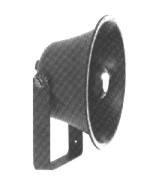
Most electronic siren horns utilize a tiny horn designed to fit discreetly in the flasher bar or on the bumper. The horn may be small and round, or small and square but in either case, it does not provide a significant amount of directional control. The directional performance of horns is related to the size of the horn. To understand this, think of what you do when you want to shout at someone at a great distance. You cup your hands around your mouth to increase the directivity of your voice. If you had a large megaphone at your disposal, you could improve this directivity enhancement even further.
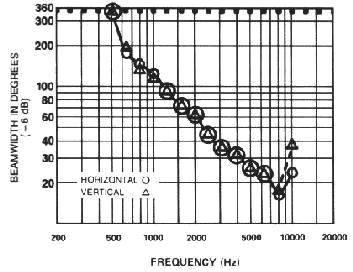
This is the graph showing the coverage of one of these small round horns. This one is actually 10" in diameter, so it has better directivity than a 6" diameter horn. To scale that directional performance for a smaller horn, shift the frequency axis by 80% so that the 120 degree coverage angle value shown for 1000Hz would be the expected angular coverage at 1800Hz, and the 360 degree coverage at 500Hz would be the 900Hz value. What this shows is that the horn has a tremendously wide coverage through the operating range of the siren, which is in the 500Hz to 1500Hz region. This means that if you held a siren horn in your hand, there would be a minimum of sound level difference when pointing it at yourself or away from you.
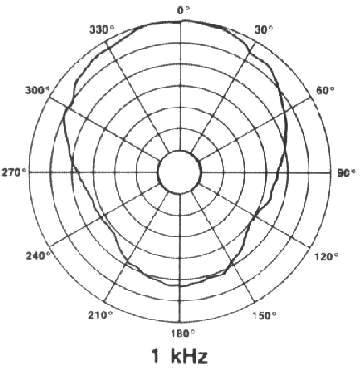
This is the coverage plot at 1000Hz (or 1800Hz for a 6" horn). Each radial increment on this graph is 5dB. Note that the level behind the device is not tremendously lower than the level in front. When mounted on a vehicle roof, or even on a cabover bumper, the level in front, behind, to the side, and above the siren is almost the same. It's no wonder that the levels measured in the cab can be as high as in front of the vehicle.
This is a picture of a larger, more directional horn. The rated coverage of this unit is 40 degrees horizontal coverage by 20 degrees vertical coverage. This horn has higher directivity than the conventional siren horn. To visualize what this means, think of the siren driver as a fire hose. If you use a straight stream nozzle you can put a lot of water in a small area. If you use a wide angle fog-stream nozzle you spread the available water over a wider area.
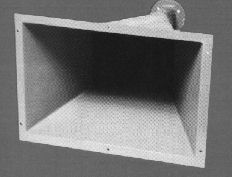
These highly directional horns are the straight stream nozzle of the siren world. Using the existing siren driver, these horns can give you greater coverage distance. And, just like the nozzle analogy, there is less water spraying the person holding the nozzle when you use the straight stream unit. In this diagram you can see that the coverage is much tighter and narrower, even at lower frequencies, when compared to the small horn above.


The small horn has 120 degrees of vertical and horizontal coverage at 1000Hz, whereas the highly directional horn has about 45 degrees of horizontal coverage, and 60 degrees of vertical coverage at 1000Hz. This does translate into a measurable improvement in the emergency vehicle application. This squeezing of the coverage raises the level along the axis of horn while dropping the sound level to the side and behind the horn.
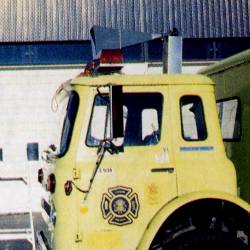
The measurements done at the Calgary Fire Department showed the magnitude of the improvements. With a cabover fire truck equipped with a standard flasher bar mounted siren, we measured a level of 98-100dBA in the driver's seat with the various types of siren signals. We measured a level of 100dBA at 50 feet in front of the vehicle.
We then placed the highly directional horn on the flasher bar and made the same measurements again. The driver's seat sound level dropped to 86-88dBA, with the worst case being the European High-Low type siren. At the same time, the sound level at 50 feet in front of the vehicle rose to 110dBA. This 10dB level change was the predicted improvement from the horn directivity index alone. That results in a level of 100dBA at a distance of 160 feet instead of 50 feet, or the ability to overcome higher noise levels inside of vehicles in front of the emergency vehicle.
During the testing with the directional horn, it was possible to converse beside the fire truck, indicating an even greater level drop at 90 degrees to the siren horn axis. Conversation beside the truck was not possible with the standard flasher bar siren unit.
Note that if 100dBA is the level that is required in front of the vehicle, the highly directional siren horn could be "turned down" by 10dB (this would mean 1/10th the amplifier or siren generator power required which would provide better reliability for the siren compression driver), which would drop the level in the cab by another 10dB to 76-78dBA! There would be a similar reduction in level curbside at right angles to the siren as well.
What does this mean on the road?
Sound outdoors falls off in level at 6dB per doubling of distance. The sound at the siren source has a maximum safe level that is largely set by the hearing protection requirements. Let's look at a general example.
Assume the siren level at 10' in front of the vehicle is 100dBA.
at 20' it will be 94dBA
at 40' it will be 88dBA
at 80' it will be 82dBA
at 160' it will be 76dBA
at 320' it will be 70dBA
at 640' it will be 64dBA
Now let's say that you need at least 75dBA of siren level to be audible through rolled up windows and over the car radio. In reality it might have to be 20dB higher if it's a boom car, or a Mercedes, or some other vehicle with very good sound isolation. The maximum warning distance you can get with a siren that begins with a 100dBA at 10' is about 160'.
At 30 MPH (44 ft/sec) closing speed that gives you about 4 seconds of warning for drivers ahead of you. At 60 MPH (88 feet per second) closing speed that only gives you 2 seconds of warning time. That's just the warning time for someone to begin to hear a siren, they still have to react and try to locate the emergency vehicle and then do something about it.
If the car has a loud audio system so that you needed 90dBA of siren level to be audible inside the car, then you only have about 35' of distance where the siren is loud enough to be heard inside the car. You're relying entirely on the flashing lights to warn the kid in the boom car, they likely won't even hear the air horn. At 30 MPH closing speed, that's less than 1 second for the driver to hear the siren and react. At 60 MPH closing speed that's less than 1/2 a second of warning time.
So if the siren can be more directional and it can be louder way out in front of the vehicle without being as loud inside or beside the vehicle, you can "reach out and touch someone" in a car and give them more warning time to react. 6dB more siren level out in front of the vehicle doubles the warning distance. 10dB more siren level out in front of the vehicle is 3.1 times more warning distance.
That extra warning time is likely going to be more important at cross street intersections than it is for vehicles moving in the same direction as the emergency vehicle.
|
Obviously there are some packaging problems with a horn this large, they aren't elegant. But when you consider the improvements in vehicle warning time, reduced levels in the driver's seat, and reduced annoyance to people standing on a side walk, the packaging problem is not that significant. If there is a product demand, the manufacturers could build a horn to suit the application specifically. These types of highly directional horns are currently available from several professional loudspeaker manufacturers such as Community and Electro-Voice/University. The horn shown above and used in the test was an Altec MR542II with an EV threaded driver adapter and EV 1824S siren driver with a standard thread-on throat. You could probably use your existing siren compression driver on a new horn. Community has a website, look for information on their Pattern Control horns with 40x20 degree coverage. Call your local pro-sound contractor, try the test for yourself.
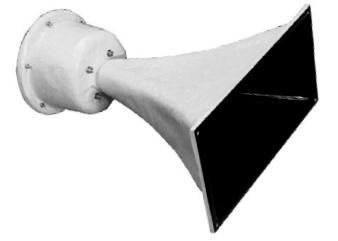
Community RMG200A horn/driver with 50x40 degree pattern
Siren Sources
We get a lot of inquiries about replacement siren drivers and other siren hardware. Here's a few links to sources for typical products. We don't particularly endorse any manufacturer's product for any particular application. This information is provided as a useful reference only. None of these manufacturers have requested a link from our site, and none have compensated us for these links. All of these devices can produce high enough sound levels to cause hearing damage if proximity or exposure is inappropriate.
|









